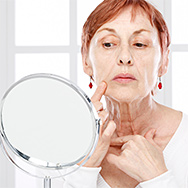
Finding the best solution for wrinkles can be a time-consuming and expensive process. Wouldn’t it be great if you could whip up your own anti-wrinkle mask, cream, or serum at home and look younger?
While it seems that it might be the simplest solution, home remedies aren’t always an easy answer; surprisingly, some of them can even make skin worse! Here’s a look at some of the more popular DIY wrinkle treatments, along with what research has shown is possible.
Facial Oils
There’s no question that non-fragrant, plant-based facial oils have benefits for skin. Most have antioxidant properties and they can be good sources of omega fatty acids, as well as having the ability to moisturize skin.
One of the most basic at-home wrinkle remedies is to put a pure oil, like olive oil or coconut oil, on the face. It’s a good solution for dry skin, but for wrinkles, you’re better off treating your skin to a more robust mix of plant oils that revitalize a dull complexion and that you can add to the anti-aging skincare products you already use.
One category of oils you should never use on your skin is essential oils. Despite claims that they can erase wrinkles and plump skin, these volatile, fragrant oils cause skin-damaging irritation. While they might smell amazing, the results can be anything but pretty. What’s especially sneaky is that their effects are often not seen for years because skin is good at hiding when it’s being irritated.
Citrus Juices and Oils
You’ve probably read one or more articles saying that a fresh squeeze of lemon or orange juice or their oils can work wonders to get rid of wrinkles. Some claims are based on citrus fruits’ antioxidant content; others tout the acids within these juices as exfoliants; and still others say these juices can brighten skin thanks to their natural vitamin C.
This is just a bad idea, full stop. Citrus ingredients, whether from juices or oils, are potent skin sensitizers. Most of them make skin more sensitive to sunlight—and sun damage is one of the leading causes of wrinkles!
Aloe Vera
Aloe vera is a great natural plant ingredient with numerous benefits. It can soothe skin, has antioxidant qualities, and hydrates. But there’s not much research showing that it has any significant impact on the appearance of wrinkles. Skin may appear plumped or look smoother immediately after application, but this is a temporary effect, not the result of a longer-term reduction of wrinkles.
Banana Masks
One of the most straightforward DIY wrinkle remedies is a banana mask. This consists of mashing up a banana, mixing it with yogurt or juice, and slathering it on your face for a few minutes. The theory is that the potassium in bananas will hydrate skin and that the antioxidants it contains will prevent or reduce signs of aging.
While a banana is a great fruit that has many health benefits, its effect in a mask is limited at best. The short-term exposure to any anti-aging ingredients it contains won’t make a big difference in wrinkles—you’ll get a much better result if you eat it instead of putting it on your face! And, do we even need to mention how sticky and messy such a mask would be?
Egg Whites
Many home-remedy mavens suggest putting egg whites on your face to tighten skin. One ingredient found in egg whites—albumin—can constrict skin temporarily, so your skin immediately appears smoother, and wrinkles will be less noticeable.
The problem is that this effect is, again, temporary, and albumin can cause skin sensitivity. Anything that irritates skin is pro-aging!
While treating your skin to the more beneficial ingredients you find in your kitchen cabinet (such as non-fragrant plant oils and aloe vera) is fine, the bottom line is that almost all at-home wrinkle remedies don’t work beyond a fleeting sensation or look of improvement, and lots of them can make matters worse.
The best solution? Use research-proven, time-tested products that follow a cocktail approach to skincare so you know you’re giving your skin the best wrinkle-reducing ingredients possible.
References for this information:
The American Cancer Society, April 2017, ePublication
Asian Pacific Journal of Tropical Biomedicine, August 2015, pages 601–611
International Journal of Antimicrobial Agents, February 2015, pages 106–110
Indian Journal of Dermatology, 2008, pages 163–166
Journal of American Academy of Dermatology, 2002, issue 5, pages 709–714



